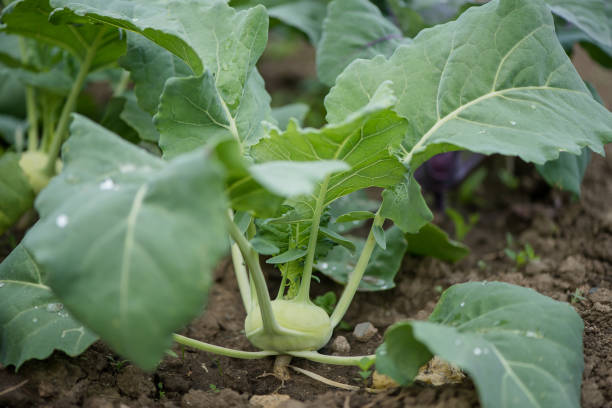

Brassica oleracea var. gongylodes L.
|
It is commonly known as Ganth-gobhi and belongs to the Brassicaceae family. Both leaves and stem are consumed as vegetable. 4-hydroxyglucobrassicin, Glucobrassicin 4-methoxyglucobrassicin (Glucosinolates), β-carotene, Quercetin are some of the bioactive compounds present in it. Methanol extracts of Green and Red Kohlrabi inhibits LPS-induced NO production in a dose dependent manner by suppression of iNOS and COX-2 protein production. Mode of Consumption : Fried and boiled |
| Plant Details | Agro-climatic Zone | Vernacular Names | Pictures |
| Scientific Name: Brassica oleracea var. gongylodes L. Family: Brassicaceae Burnett Class: Magnoliopsida Order: Brassicales Genus: Brassica L. Fruiting Season: February to April Parts: Leaves & Stem |
|
Assam : Ol-kobi, Ganth-gobhi Bihar : Ganth-gobhi Delhi : Ganth-gobhi Gujarat : Nol- Kol Haryana : Ganth-gobhi Jammu & Kashmir : Hakh, Munj haakh Jharkhand : Ganth-gobhi Karnataka : Gade-kosu, Navil-kosu Madhya pradesh : Ganth-gobhi Rajasthan : Ganth-gobhi Uttar pradesh : Ganth-gobhi Uttarakhand : Ganth-gobhi West Bengal : Ol-kobi |
 Plant |
| Compound/Extract | Activity | Mode of Action | Marker/References |
| Ethyl acetate fraction | Anti-inflammatory, Antioxidant | Ethyl acetate fraction of Kohlrabi inhibited the production of NO and PGE2 and the protein level of iNOS and COX-2, and protein expression of pro-inflammatory cytokines (TNF-α, IL-6 and IL-1β), in a dose-dependent manner. | NO, PGE2, iNOS, COX-2, TNF-α, IL-6, and IL-1β[1] |
| Methanolic extract | Antidiabetic, Anti-inflammatory | Methanolic extracts of Green and Red Kohlrabi inhibited LPS-induced NO production in a dose dependent manner by suppression of iNOS and COX-2 protein production. | iNOS and COX-2[2] |
| Major Class | Metabolites (Content of bioactives: mg/100g Fresh Weight) |
| Carotenoid | Lutein: 0.076 mg/100g, β- Carotene: 0.134 mg/100g[3] |
| Flavonoid | Kaempferol: 1.264 mg/100g[3] |
| Glucosinolate | 4-Hydroxyglucobrassicin: , Glucobrassicin 4-methoxyglucobrassicin: , Glucoerucin: , Glucoraphanin: , Glucotropaeoline: , Neoglucobrassicin: 0.262 mg/100g, β-thioglucoside-N-hydroxysulfates: [3] |
| Glucosinolates | Glucoalyssin: [3] |
| Phenylpropanoid | 4-hydroxybenzoic acid: 4762.506 mg/100g, Benzoic acid: 5.008 mg/100g, Caffeic acid: 2.762 mg/100g, p-coumaric acid: 2.27 mg/100g, Quercetin: 1.152 mg/100g, trans-Cinnamic acid: 0.216 mg/100g[3] |
| Effect | Observation | DOI |
| Disease | Formulation | Reference | Author | TKDL |
| Information from Wealth of India | Reference |
|
CSIR(1948).The Wealth of India, Raw materials,Vol.-I ,P.221, New Delhi, India |
| 4.2, 04.2.1, 04.2.1.1, 04.2.1.3, 04.2.2.5, 04.2.2.6, 04.2.2.8 |
| CSIR-North East Institute of Science and Technology, Jorhat-6, Assam, India
CSIR-Institute of Himalayan Bioresource Technology, Palampur-61,Himachal Pradesh, India |